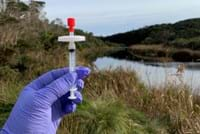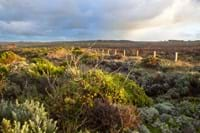
Burnett Mary Regional Group (BMRG) engaged EnviroDNA to undertake a biodiversity assessment for native fauna as part of a project developing a comprehensive environmental account of natural assets in the region. Measuring biodiversity across large-scale environments is difficult and costly using traditional monitoring techniques. BMRG applied an EnviroDNA Method under the Accounting for Nature framework that uses eDNA to support large scale monitoring.
Metabarcoding/natural capital
Natural resource management
Covering approximately 56,000km2 of land and 11,000km2 of sea, the Burnett Mary Region is internationally renowned for its ecological diversity, extensive primary production and rich cultural heritage. Burnett Mary Regional Group (BMRG) engaged EnviroDNA to undertake a biodiversity assessment for native fauna as part of a project developing a comprehensive environmental account of natural assets in the region. Measuring biodiversity across large-scale environments is difficult and costly using traditional monitoring techniques.
BMRG applied an EnviroDNA Method under the Accounting for Nature framework that uses eDNA to support regional-scale land management. Water samples were taken to obtain high quality baseline aquatic vertebrate biodiversity data using eDNA metabarcoding to help inform on-ground conservation strategies. In May to August 2022, 149 water samples with matched hydrochemical data were collected from sites within the Burnett Mary region by BMRG staff and affiliated stakeholders. EnviroDNA analysed samples for native vertebrate fauna throughout the catchment area.
Across the 149 samples taken, the eDNA metabarcoding assay detected many native and introduced species in the region sampled. Overall, at least 111 taxa were detected, with those identified to species level including 42 fish, 9 amphibians, 28 birds, 6 reptiles and 26 mammals. Site level taxa counts across replicate samples varied from 1 to 33 (with a median value of 21), including listed or iconic species such as the Mary River turtle, white-throated snapping turtle, platypus, and Australian lungfish. An environmental account snapshot and certification report is available on the Accounting for Nature website.
This study demonstrates the increased recognition of the importance of natural capital and the need for it to be accurately measured and valued at the landscape-scale. Coupled with appropriate legislation protecting environments, directly and indirectly, natural capital accounting has an important role to play in recognising the value of biodiversity. The Burnett Mary region will ultimately benefit through increased public and private investment that will continue to improve the environment. Local farmers and landowners will also benefit from new sustainable revenue streams, as well as reduced input costs and increased productivity from healthier land.
Burnett Mary Regional Group as managers of this project within the Burnett Mary region and Accounting for Nature for the framework that underpins this eDNA method. For more information on this project, follow the links below:

EnviroDNA has developed a Method that uses eDNA to support regional-scale land management and facilitate positive environmental outcomes. Accounting for Nature, global leaders in measuring the change in environmental condition, commissioned this Method to monitor the condition of aquatic vertebrate fauna over time. It provides land managers an opportunity for environmental accounting across regional scales using a framework backed by rigorous scientific standard.
